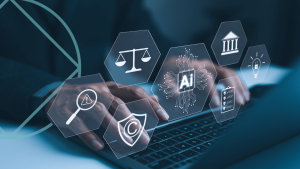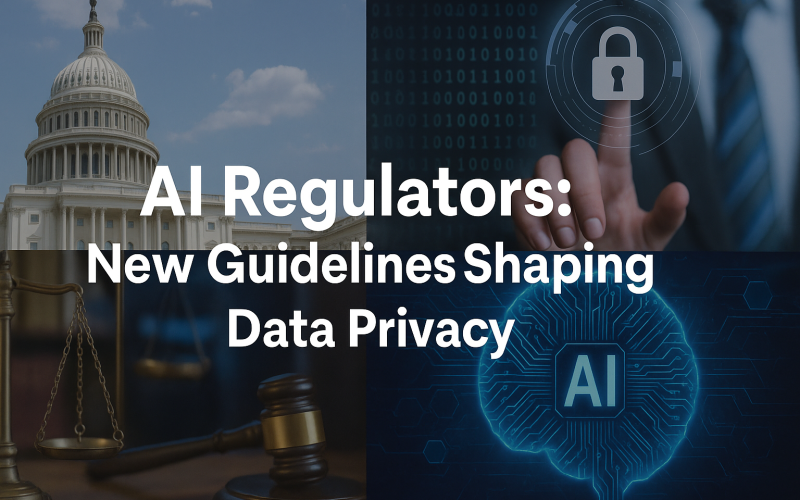Introduction
Artificial intelligence is at the heart of today’s innovations. From voice assistants to personalized ads, AI touches almost every part of our daily life. As AI grows, data privacy moves to center stage. Regulators worldwide have stepped in. They aim to set clear rules that keep our personal data safe. These AI regulators issue data privacy guidelines that shape how companies design and deploy AI systems.
You will learn key points about AI governance frameworks, compliance tips, and the future of AI regulation. By the end, you will have a clear picture of how these rules influence user data protection and why acting now is vital.
What Is AI Regulation?

Artificial intelligence is no longer a clever side project—it powers everything from banking apps to medical scans. As its reach grows, governments want clear rules so people stay safe and data stays private. AI regulation means setting legal limits on how systems collect, store, and use personal information. It also covers fairness, transparency, and accountability. In short, it decides who can do what with your data and how they must protect it.
Defining AI Governance
Governance includes hard laws, industry codes, and technical standards. Laws create the baseline. Voluntary codes help firms go further. Technical standards make sure tools meet the same safety bar. Together, they keep AI trustworthy while still letting new ideas flourish.
Purpose
The main goal is to protect individuals and society. Regulators aim to prevent misuse of AI, such as biased decision-making or data leaks. They also promote trust. Clear guidelines help businesses innovate while respecting user rights.
Why the Surge in Rules Now?
Several triggers sparked action. First, huge data leaks showed gaps in current privacy laws. Second, advanced models like GPT-4o made it clear that algorithms can shape opinions and markets. Third, voters asked lawmakers to act before harms spread. All this pressure has pushed regulators to draft stricter, faster rules than ever before.
Challenges Organizations Face
Organizations often struggle with new AI regulations. One major challenge is compliance cost. Mapping data flows and auditing algorithms takes time and budget. Smaller firms may lack staff or funds for thorough reviews.
Another challenge lies in technical limitations. Some AI models are “black boxes.” They make decisions in ways even developers can’t fully explain. Meeting “right to explanation” rules can require redesigning or simplifying algorithms.
How New Guidelines Are Reshaping Data Privacy

Fresh policies replace vague promises with measurable duties. They force firms to move from “collect everything” to “collect only what you truly need.” The result is a stronger focus on individual rights and company accountability.
Shift From Consent to Accountability
Old privacy models relied on user consent forms no one read. New rules demand documented risk checks, clear impact reports, and proof of safe data handling. Companies must show regulators—on request—exactly how an algorithm uses each data field.
Role of Risk Assessments
Most modern guidelines split AI into risk levels. Low risk tools (spam filters) get light oversight. High risk tools (credit scoring, medical advice) must run regular audits, allow human review, and post detailed summaries online. This tiered model lets small startups innovate while keeping critical sectors under a microscope.
Key Global Regulators and Their Latest Moves
Governments on every continent have rolled out or updated AI guidelines between 2024 and mid-2025. Each region uses its own lens, yet overlapping themes emerge.
European Union: The AI Act
The EU’s AI Act is first to create a union-wide rulebook. It bans social-scoring systems, demands impact assessments, and fines violators up to 7 percent of global revenue. It also expands GDPR by adding algorithmic transparency steps.
United States: Executive Orders and State Laws
The U.S. relies on a patchwork approach. A late-2024 White House order set Federal guiding principles for safety, bias testing, and watermarking AI-generated content. States like California and New York followed with stronger privacy bills, forcing firms to publish how they use sensitive data in training sets.
China: Algorithmic Review Measures
China’s 2025 rules build on its 2022 algorithm registry. Big platforms must file new models before release, disclose training data sources, and pass a security review if tools influence public opinion. The focus is social stability and national security.
Emerging Markets: Brazil, India, Kenya
Brazil’s Congress advanced PL 2338/23, which mirrors the EU’s risk tiers but adds local data storage for health records. India published its “Digital India Bill” draft, stressing open-source audits for high-impact systems. Kenya updated its Data Protection Act to cover AI profiling, a first in Africa.
| Region | Key Law / Policy | Core Focus | Enforcement Start | Max Fine |
|---|---|---|---|---|
| EU | AI Act | Risk tiers, openness, bans on social scoring | Q4 2025 | 7 % global revenue |
| USA | Executive Order + State Acts | Safety tests, watermarking, bias checks | Rolling 2025 | $10 M per offense (state-level) |
| China | Algorithmic Security Rules 2.0 | Model registry, national security, content control | Jan 2025 | 5 % domestic revenue |
| Brazil | PL 2338/23 | Local health data, rights to explanation | Draft—expected late 2025 | 2 % domestic revenue |
| India | Digital India Bill | Open audits, user grievance boards | Draft—public comments | To be set |
| Kenya | DPA Amendment 2024 | AI profiling limits, consent clarity | July 2025 | $50 K or 1 % revenue |
Challenges Companies Face Under the New Rules
Regulations promise safer tech, yet they raise real hurdles for firms—large and small.
Navigating Patchwork Compliance
Global brands must juggle many rulebooks. A chatbot in Berlin must meet EU risk labels. The same bot in Boston needs bias tests for state auditors. Mapping overlaps and gaps eats legal budgets and slows launches.
Data Localization and Cross-Border Flows
Some laws push for data storage inside national borders. While intended to protect citizens, this forces companies to duplicate servers, adding cost and complexity. Cloud providers now market “sovereign clouds” to help, but smaller firms still struggle.
Balancing Innovation With Responsibility
Strict rules can chill bold experiments. Startups fear fines, so they may delay public tests that could reveal bias early. Regulators stress a “sandbox” approach—safe spaces for trials—but adoption remains uneven.
Practical Tips for Staying Compliant

Regulation may be complex, but clear steps can cut risk and keep projects on track.
Build a Privacy-First Culture
Compliance starts with people. Train every team, from design to marketing, on privacy basics. Reward early flagging of risks instead of punishing whistle-blowers.
Map Your Data and Algorithms
Know where data enters, how it is processed, and who sees outputs. Updated inventories let you answer regulator questions fast.
Adopt Explainable AI
Choose models that allow human-readable summaries of decisions. Explanations not only meet legal needs but also build user trust.
Monitor the Regulatory Horizon
Track draft bills and public consultations. Comment when possible—your voice may shape lighter, clearer rules.
The Future of AI Regulation
The next wave will likely blend national systems into common frameworks.
Toward Global Harmonization?
Bodies like the OECD and G20 are drafting alignment principles. A shared set of definitions—risk, bias, transparency—could reduce overlap. Companies would then certify once and sell everywhere, much like existing ISO safety marks.
Role of Industry Self-Regulation
Regulators welcome help from trade groups. Voluntary labels, benchmark tests, and code-of-conduct seals can fill gaps between hard laws. They also move faster, updating yearly instead of once a decade.
By 2030, experts expect a layered model: firm-led codes on top, regional laws in the middle, and a light global charter above. Such a stack balances local values with universal safeguards.
Conclusion
AI regulators worldwide are racing to turn bold ideas into enforceable rules. Each new guideline aims to protect personal data, curb bias, and maintain public trust while letting innovation thrive. For companies, the message is clear: view privacy not as a paperwork hurdle but as a core design goal. Build transparent systems, keep audits current, and engage with policymakers early. Those who adapt today will lead tomorrow’s AI landscape and win customer confidence along the way.
Call to Action: Ready to future-proof your AI projects? Visit our free compliance hub for clear checklists, expert webinars, and policy alerts that keep your team ahead of every new rule.












